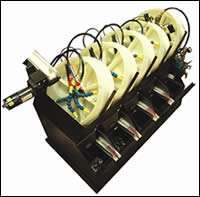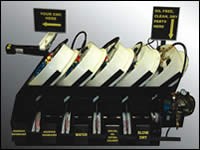Continuous, In-Process Washing System For High-Production Machines
Dan Walters' invention is a part washing machine that attaches directly to the machine tool while occupying about 10 square feet of floor space. The Wheelie Washer is a conveyor-like system that takes the parts through various chemicals and solutions, removing the oil from each part and drying them.
In many shops, the parts washing operation can be a bottleneck for continuous production efforts. Many parts washing systems operate on a batch principle that requires parts to accumulate before being run through the washer. Often, these systems are located away from the machining floor, therefore, batches must be transported around the shop.
All of this handling can make removing oil, washing out parts in different solutions and drying parts a costly process. Moreover, increasingly, customers are demanding no-mar specs on parts that make handling them in baskets and batches less appealing.
Featured Content
That was the problem for American Torch Tip Co. in Bradenton, Florida. The shop was making as many as 50,000 parts each day, therefore, parts washing got to be a problem. Production Machining first encountered this innovative company last year and published an article (No Touch Up Needed For ER Collet Tools) about the quick-change ER collet system that the shop’s CNC manager, Dan Walters, invented for use on American Torch Tip’s 30 CNC machine tools, including 17 Swiss types.
At PMTS 2007, Dan displayed his newest idea for inexpensive, yet effective, continuous in-process parts cleaning. He named it the Wheelie Washer. Once again, born out of necessity and proven in his own shop first, this parts washer has relieved several of the bottleneck issues associated with higher-volume parts washing on his shop floor.
His invention is a part washing machine that attaches directly to the machine tool while occupying about 10 square feet of floor space. The Wheelie Washer is a conveyor-like system that takes the parts through various chemicals and solutions, removing the oil from each part and drying them.
“It’s no different than adding a special tool to a machine to eliminate an extra operation. In this case, we added this tool at the end of the machine,” Dan says. The Wheelie Washer has become so effective in his shop that Dan applied for a patent and has decided to put the machine into the market.
Here’s how the parts washer works:
Leaving the machine: Because each machine tool is different, the Wheelie Washer has an adjustable height platform for the conveyor belt that accepts a part as it comes off the machine. As soon as the part is on the conveyor and enters an oil-free environment, several things begin to happen. Since the part is moving, the bulk of the oil and chips fall off the part onto the belt. The oil is recovered in a drip pan under the conveyor and is transferred back into the machine with an attached hose. The chips go into the same pan to be recovered later. Then, it carries the part to the first wheel to begin the washout process.
Begin to clean: As the part falls off the belt conveyor and into the initial wheel, it does not come into contact with any metal surface, only plastic. The part is then sprayed with a cleaning solution of choice. As the wheel indexes, the part climbs up the wheel in compartments. During this climb, the part sits differently each time the wheel indexes, allowing a spray to emit around and in the part, which also washes out any chips. The wheel is canted so the oil and chips are flushed under the wheel and into a chip pan that sits between the wheel and the tank. The indexing speed of the wheels can be synchronized to the machine’s cycle time, so the parts never touch each other during the wash. The part then exits the wheel through a hole in the top of the unit, enters the next wheel and is sprayed with another cleaning solution of choice.
Chemicals: As with any washing system, the right chemicals can be as important as the machine itself. Almost all high-production machine tools use some type of cutting oil. The oil tends to stick to the part, requiring agitation or movement to break that bond between the oil and the part. With the Wheelie Washer, that process happens in a different way. The key is in the last wheel unit before the blow dry. Here, a type of odorless mineral spirit is recommended because when any oil comes in contact with a part, the oil immediately dissolves into this solvent. Along with the natural agitation caused by the wheel moving the part when it indexes and the fluid movement over the part, the oil is removed completely. This mineral spirit solvent is used only on the next to last wheel to help extend the solvent’s life because most of the oil is removed in the first couple of wheels that use less expensive aqueous degreasers.
Each wheel unit’s holding tank has its own disc-style oil skimmer to skim the oil off of the top. The fluids are pumped from the bottom of the tank using only the freshest part of the fluid. In addition to removing the oil, the mineral spirit solvent also contains a corrosive protection and a rust preventive. It has a better evaporation rate, making the blow-dry wheel more efficient in blowing off the solvent. The remaining solvent on the part will easily air dry without staining the part because it has no water in it.
Oil-free and dry: The last wheel unit consists of a blow-dry system using air nozzles with compressed air. A simple timer can be set to control the amount of time the air stays on the parts after each wheel index. The parts then fall down a slide to the finished part bin. The height is adjustable to allow different-sized bins to catch the parts.
At this point, there has been a secondary operation replaced with an automated in-process part cleaner, which results in money saved. The washer is available in three-, four- or five-wheel units configurable with several different combinations to match part cleaning needs.
RELATED CONTENT
-
Cleaning and Corrosion Protection with Solvents
Protect parts against rust in an efficient and sustainable way.
-
Cleanliness Compliance is Critical for Automotive Suppliers
Although not every shop has been affected by cleanliness specifications, many suppliers to automotive OEMs are already complying with stringent cleanliness standards. In Ford Motor Co.’s case, it has created its own cleanliness standards in order to save money and credibility.
-
Heat’s Impact on Parts Cleaning
Thermal dynamics is important for assisting in the cleaning of a part. Adding heat or energy influences the cleaning process through its impact on chemistry, the water within the washer and its effect on drying.









